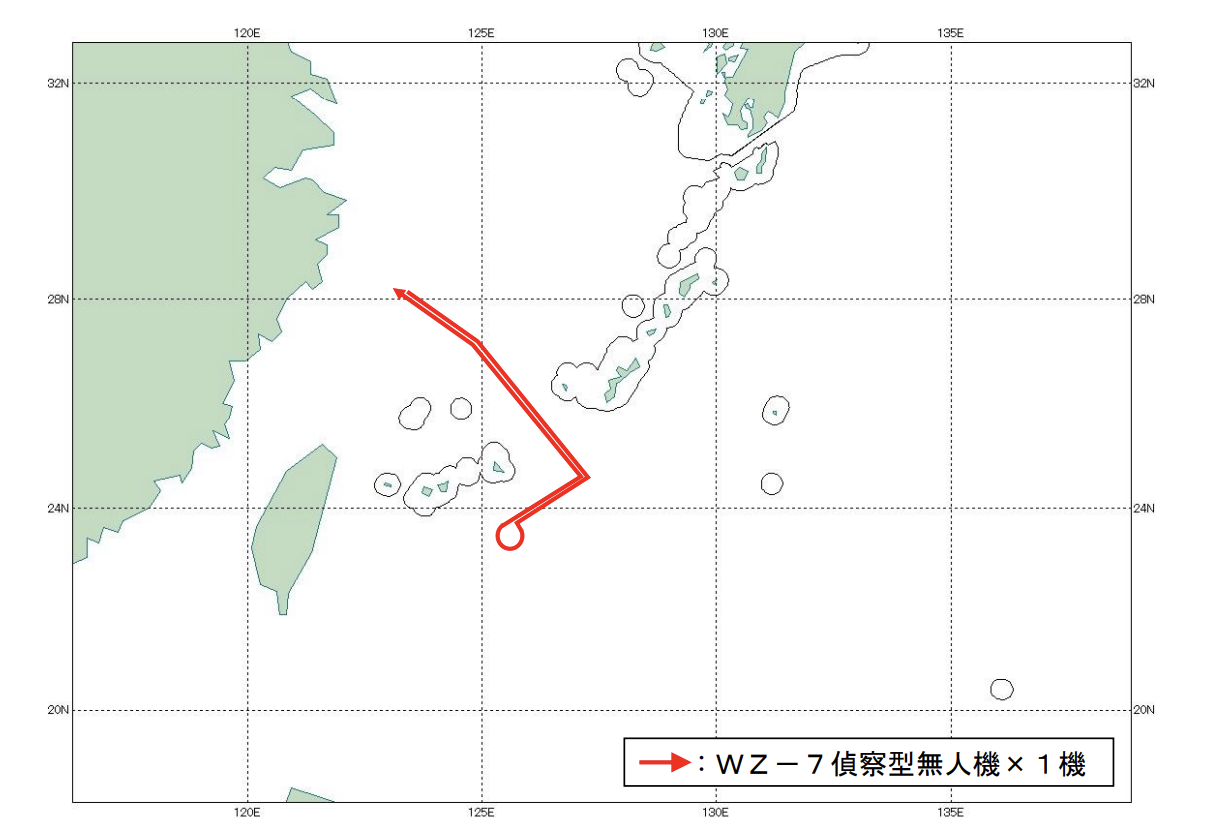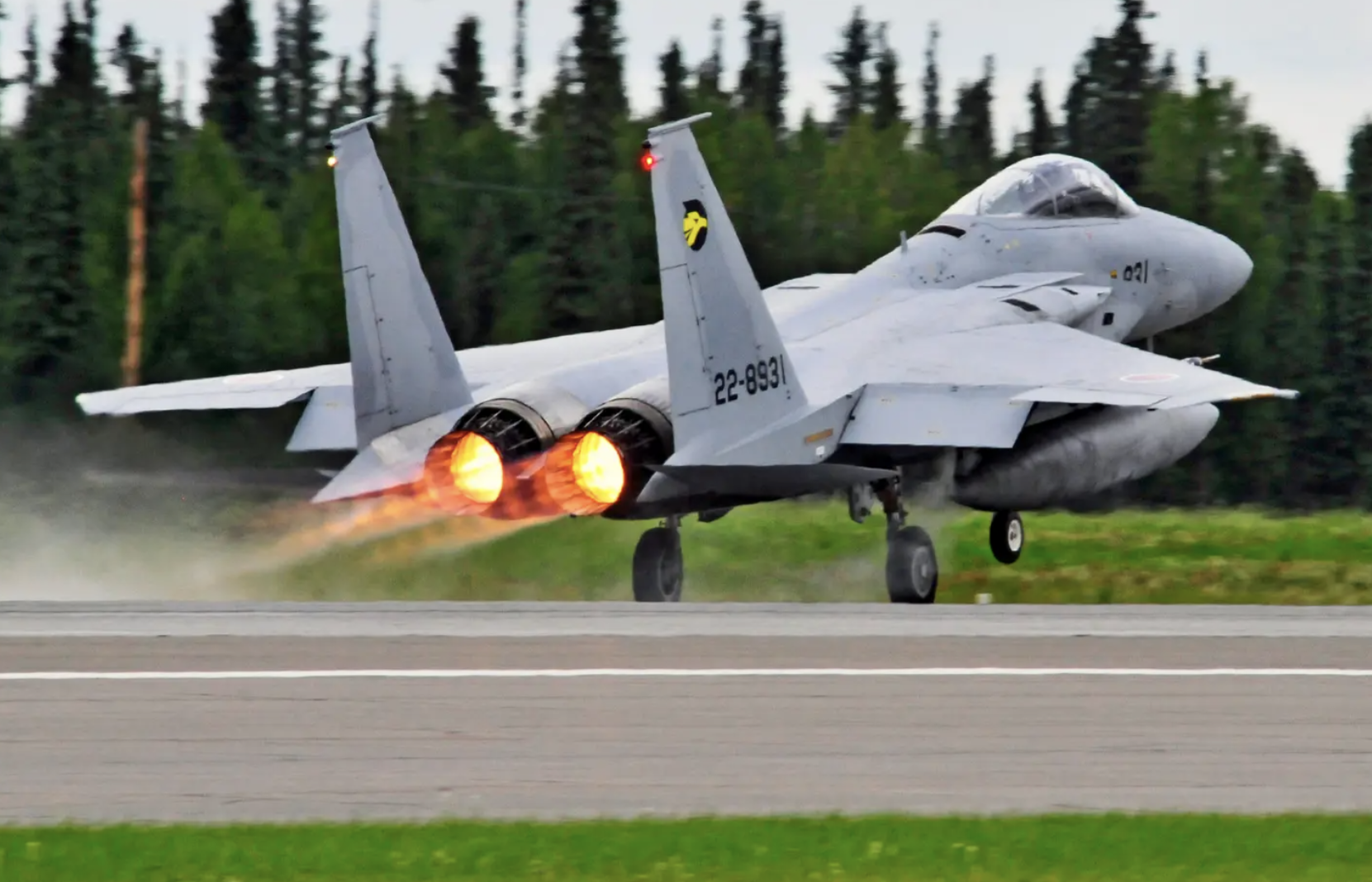Chinese WZ-7 surveillance drones have appeared for two days in a row over the East China Sea, prompting Japanese fighter jets to scramble to intercept them on both occasions. This is the first time that the Japanese authorities have reported intercepts of the WZ-7, one of the most advanced drones in Chinese service, and it could be connected with the recent movements of the Chinese aircraft carrier Liaoning and its supporting task force in the same area. Either way, the intelligence, surveillance, and reconnaissance (ISR) drone, with its unique joined-wing design, may well become a more regular feature of Chinese activities in the wider region, providing capabilities loosely analogous to the RQ-4 Global Hawk.
Yesterday, January 1, the Japanese Ministry of Defense (MoD) disclosed that a single WZ-7 — the type is also known as the ‘Soaring Dragon’ — had been active in the East China Sea as part of a mission that lasted from the morning to the afternoon, local time. According to the MoD’s statement, the drone appeared over the East China Sea, then passed through the Miyako Strait, which separates the main island of Okinawa and the Miyako Islands, which are also part of Okinawa Prefecture but which are located around 160 miles to the west. Once over the Philippine Sea, the drone flew south of Japan’s Sakishima Islands, further to the west, then reversed its course and headed back toward the main island of Okinawa.

In response, the Japanese MoD confirmed that fighters from the Southwestern Air Force of the Japan Air Self-Defense Force, or JASDF, were scrambled to respond. Unconfirmed reports suggest that F-15J Eagle fighter jets were involved, which would make sense as these aircraft are based at Naha Air Base on the main island of Okinawa.
A tweet from the Japan Joint Staff reporting on a previous scramble by JASDF F-15J fighter jets over the East China Sea, in October 2022:

Today, the Japanese MoD again reported activity by another WZ-7 drone, in the same timeframe and flying an almost identical path from the East China Sea out into the Philippine Sea, bringing it close to Okinawa and other outlying Japanese islands. Exactly how close the drone came to Japanese territory or Japan’s exclusive economic zone is unclear, but there’s no indication that the WZ-7s in question departed from international airspace. It’s also worth noting that, further west, is the island of Yonaguni, the westernmost inhabited island of Japan, just off the east coast of Taiwan. With recently announced Japanese plans to deploy a surface-to-air missile defense unit here, this location is also likely to be of growing interest to China.
Meanwhile, the Japanese MoD disclosed that the carrier Liaoning had passed through the Miyako Strait on January 1. Transiting from the Philippine Sea into the East China Sea, the flattop was accompanied by the People’s Liberation Army Navy (PLAN) Type 055 destroyers Anshan and Wuxi, the Type 052D destroyer Chengdu, the Type 054A frigate Zaozhuang, and the Type 901 fast combat support ship Hulunhu. According to the MoD, between Wednesday and Saturday of last week, the Liaoning conducted flight operations involving around 20 launches and recoveries of fighters and some 40 take-offs and landings by helicopters. Again, JASDF fighter jets were scrambled in response to fighter activity aboard the carrier. Between December 17 to 31, meanwhile, the PLAN carrier completed roughly 320 takeoffs and landings of both fighters and helicopters, according to the Japanese MoD account.
As for the WZ-7, the standout feature of this intriguing drone is the diamond-wing design, with the swept main wing joined to forward swept flying surfaces that terminate at the base of the vertical tail. Since its first appearance as a technology demonstrator in 2011, the design of the drone has changed significantly and it reappeared in its revised form in late 2013, now featuring canted vertical tail surfaces. Produced by the Guizhou Aircraft Industry Corporation, the drone made its public debut at the Zhuhai Air Show in 2021, and we also got to have a closer look at it during the 2022 edition of the show.


The WZ-7 is jet-powered, with an estimated range of 4,350 miles and a service ceiling of some 60,000 feet. Its endurance isn’t known – at least 10 hours is likely – but the real number for a normal long-endurance mission could be much higher than that. This ambiguity means that it may fall someway short in the high-altitude, long-endurance (HALE) category compared to the RQ-4 Global Hawk, for example, although its high-altitude capability and large sensor payload make it well suited to peering deep into regional adversary countries from international airspace. China’s even larger and higher-flying Divine Eagle is likely set to fulfill China’s growing HALE needs in the years to come, as well. Stealthy types are also possible.
The WZ-7 is in service with both the PLAN and the People’s Liberation Army Air Force, or PLAAF. With the PLAAF, the WZ-7 has notably been used around Tibet, to peer over the border into India. In addition to these operations, it has been flown from the highly strategic Yishuntun Airbase close to the North Korean border.
While the JASDF has not previously intercepted the WZ-7, scrambling fighters to meet Chinese drones flying in the East China Sea and the Miyako Strait is by no means new. You can read our reporting on a previous flurry of such activity, in this case involving the TB-001 and BZK-005 medium-altitude, long-endurance (MALE) drones, here.
Chinese maritime patrol and electronic intelligence aircraft have also been encountered in the past flying similar routes, while Japan also monitors Chinese naval vessels as they pass through the Miyako Strait, including the aircraft carrier Liaoning and its task group, back in 2021.
Drone intercepts in particular reinforce the rapid developments in unmanned aircraft capabilities that are currently being made by the Chinese military. Meanwhile, the strategic significance of this body of water is obvious, since it provides a maritime passage connecting the East China Sea to the Philippine Sea, and the wider expanses of the Western Pacific.

Compared to the TB-001 and BZK-005 that have been encountered here in the past, however, the WZ-7 offers an overall expanded level of capability. Its large size means it can provide multi-sensor intelligence gathering for a longer duration and over greater distances. It can also operate at higher altitudes, increasing sensor reach as well as providing more extensive beyond-line-of-sight connectivity capabilities. This could also come into play with the drone serving in a networking capacity for naval task forces, including carrier groups.
All in all, while the specific details of the WZ-7’s performance and sensor fit remain limited, the drone would appear to provide China with a highly efficient platform for collecting multiple types of intelligence over and around the highly strategic Miyako Strait, and elsewhere too. Just last week, a WZ-7 was among the manned aircraft and drones that constituted the largest number of such platforms to enter Taiwan’s Air Defense Identification Zone, or ADIZ — 71 in all, according to Taiwan’s Ministry of Defense. You can read more about that incident and its implications here.
It certainly seems highly possible that the WZ-7 activity in and around the Miyako Strait could be connected with the movements of the Liaoning and its task group, but we cannot be sure about that. Moreover, the PLAN’s growing blue-water ambitions, within which carrier operations are central, are only set to grow as Beijing adds new carriers and seeks to improve its overall capacity to project power afar. As we see the PLAN carrier groups expand their operations westward, we will very likely see increased activity by these drones, and others like them, too.
Whatever the case, having WZ-7s on station before, during, and after the task group’s transit of the Miyako Strait would be a very useful capability. For example, the drones could keep tabs on Japanese and other foreign warship movements, as well as collect and catalog electronic emissions from adversaries’ radar and communications systems as they work to respond to the Chinese carrier group. This is alongside their ability to generate high-resolution radar maps of the area and collect imagery of vessels of interest. Another important factor is monitoring the JASDF response to the presence of the drones themselves, providing data on response times plus tactics, techniques, and procedures. These drones could also provide a critical data relay function for a carrier group below.
It will be interesting to see if WZ-7s continue to appear over the strait, and in the general area, in the days to come, or whether this was a temporary spike in activity more likely connected with the recent movement of the Liaoning. The latest cruise by this carrier has been interesting in itself, with Chinese media reporting that it came closer to the key U.S. military outpost at Guam than it had ever been before. As such, we could see WZ-7 sorties even farther out in the Pacific.
Whatever the case, the appearance of WZ-7s in the last two days provides even more evidence of the pacing change of China’s unmanned capabilities and the fact that the People’s Liberation Army at large now offers some highly advanced and unorthodox designs. The importance of drones like the distinctive WZ-7 is only likely to grow in the future as tensions continue to simmer in the highly strategic Indo-Pacific region, especially as China pushes out farther from its shores and continues to expand its military operations.
Contact the author: thomas@thedrive.com
